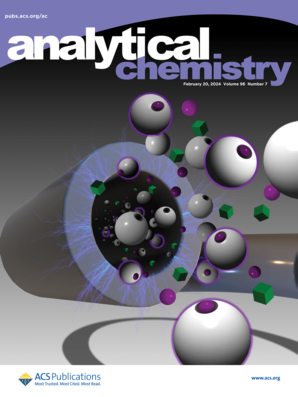Low-background Near-infrared Fluorescent Probe for Real-time Monitoring of β-Glucuronidase Activity in Inflammation and Therapy
IF 6.7
1区 化学
Q1 CHEMISTRY, ANALYTICAL
引用次数: 0
Abstract
β-Glucuronidase (GUS) is an acidic hydrolase enzyme overexpressed in various inflammatory diseases, making it a promising biomarker for inflammation. However, current tools for real-time, in situ imaging of GUS activity are hindered by background interference, which reduces their effectiveness in dynamic biological environments. To address this challenge, we developed Ox-GUS, a GUS-specific fluorescent probe with a unique molecular design featuring a disrupted conjugated structure. This design provided Ox-GUS with near-zero background optical properties, a significantly enhanced signal-to-noise ratio, and a highly sensitive detection ability. The probe demonstrated a fluorescence enhancement of up to 400 folds in response to GUS activity, with a detection limit as low as 0.0035 U/mL. We successfully employed Ox-GUS to visualize GUS activity in real-time in mouse models of rheumatoid arthritis, autoimmune hepatitis, and inflammatory bowel disease, and effectively monitored therapeutic responses. This study highlights the potential of Ox-GUS as a robust tool for advancing research on GUS-related inflammatory mechanisms and for early diagnosis and treatment monitoring of inflammatory diseases.

低背景近红外荧光探针实时监测炎症及治疗中β-葡萄糖醛酸酶活性
β-葡萄糖醛酸酶(GUS)是一种酸性水解酶,在多种炎症性疾病中过表达,是一种很有前景的炎症生物标志物。然而,目前用于实时、原位GUS活性成像的工具受到背景干扰的阻碍,这降低了它们在动态生物环境中的有效性。为了解决这一挑战,我们开发了Ox-GUS,一种gus特异性荧光探针,具有独特的分子设计,具有断裂共轭结构。该设计使Ox-GUS具有接近零的背景光学特性,显著提高了信噪比,并具有高灵敏度的检测能力。该探针对GUS活性有400倍的荧光增强,检出限低至0.0035 U/mL。我们成功地利用Ox-GUS在类风湿性关节炎、自身免疫性肝炎和炎症性肠病小鼠模型中实时可视化GUS活性,并有效地监测治疗反应。这项研究强调了Ox-GUS作为推进gus相关炎症机制研究和炎症性疾病早期诊断和治疗监测的强大工具的潜力。
本文章由计算机程序翻译,如有差异,请以英文原文为准。
求助全文
约1分钟内获得全文
求助全文
来源期刊

Analytical Chemistry
化学-分析化学
CiteScore
12.10
自引率
12.20%
发文量
1949
审稿时长
1.4 months
期刊介绍:
Analytical Chemistry, a peer-reviewed research journal, focuses on disseminating new and original knowledge across all branches of analytical chemistry. Fundamental articles may explore general principles of chemical measurement science and need not directly address existing or potential analytical methodology. They can be entirely theoretical or report experimental results. Contributions may cover various phases of analytical operations, including sampling, bioanalysis, electrochemistry, mass spectrometry, microscale and nanoscale systems, environmental analysis, separations, spectroscopy, chemical reactions and selectivity, instrumentation, imaging, surface analysis, and data processing. Papers discussing known analytical methods should present a significant, original application of the method, a notable improvement, or results on an important analyte.
 求助内容:
求助内容: 应助结果提醒方式:
应助结果提醒方式:


